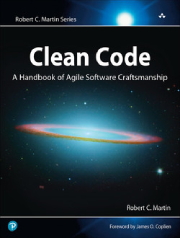
عنوان:
Clean Code: A Handbook of Agile Software Craftsmanship
نویسنده:
Robert C. Martin(Uncle Bob)
انتشارات:
Pearson
تاریخ انتشار
2008
حجم:
2.8MB
معرفی کتاب: "کتاب کد تمیز: راهنمای مهارت در توسعهی نرمافزار چابک "
حتی کدهای بد هم میتوانند کار کنند. اما اگر کدی «تمیز» نباشد، میتواند یک تیم توسعه نرمافزار را به زانو درآورد. هر سال، منابع ارزشمندی به خاطر کدهای بد از بین میرود. اما لازم نیست این روند ادامه داشته باشد.
رابرت سی. مارتین، از متخصصان برجستهی نرمافزار، با کتاب کد تمیز (Clean Code) پارادایمی نو در توسعهی نرمافزار معرفی میکند. او با همکاری تیم Object Mentor، اصول و شیوههای نوشتن کد تمیز را در قالب راهنمایی کاربردی برای توسعهدهندگان گردآوری کرده است.
ساختار کتاب
- بخش اول: اصول، الگوها و روشهای نوشتن کد تمیز
- بخش دوم: مطالعات موردی برای تمرین پاکسازی کد
- بخش سوم: قواعد تجربی و نشانههای کد بد (Code Smells)
پس از خواندن این کتاب خواهید آموخت:
- ✓ تشخیص تفاوت میان کد خوب و کد بد
- ✓ نوشتن کد خوانا، قابل نگهداری و قابل اعتماد
- ✓ انتخاب نامهای مناسب برای توابع و متغیرها
- ✓ طراحی توابع و کلاسهای تمیز و ساده
- ✓ مدیریت خطا به شکلی موثر بدون پنهان کردن منطق برنامه
- ✓ تمرین تستنویسی و TDD با تستهای واحد
این کتاب برای توسعهدهندگان نرمافزار، مهندسان، رهبران تیم و علاقهمندان به کیفیت کد یک منبع ضروری است.
فهرست مطالب
- Clean Code
- Contents
- Foreword
- Introduction
- On the Cover
- Chapter 1: Clean Code
- There Will Be Code
- Bad Code
- The Total Cost of Owning a Mess
- Schools of Thought
- We Are Authors
- The Boy Scout Rule
- Prequel and Principles
- Conclusion
- Bibliography
- Chapter 2: Meaningful Names
- Introduction
- Use Intention-Revealing Names
- Avoid Disinformation
- Make Meaningful Distinctions
- Use Pronounceable Names
- Use Searchable Names
- Avoid Encodings
- Avoid Mental Mapping
- Class Names
- Method Names
- Don't Be Cute
- Pick One Word per Concept
- Don't Pun
- Use Solution Domain Names
- Use Problem Domain Names
- Add Meaningful Context
- Don't Add Gratuitous Context
- Final Words
- Chapter 3: Functions
- Small!
- Do One Thing
- One Level of Abstraction per Function
- Switch Statements
- Use Descriptive Names
- Function Arguments
- Have No Side Effects
- Command Query Separation
- Prefer Exceptions to Returning Error Codes
- Don't Repeat Yourself
- Structured Programming
- How Do You Write Functions Like This?
- Conclusion
- SetupTeardownIncluder
- Bibliography
- Chapter 4: Comments
- Comments Do Not Make Up for Bad Code
- Explain Yourself in Code
- Good Comments
- Bad Comments
- Bibliography
- Chapter 5: Formatting
- The Purpose of Formatting
- Vertical Formatting
- Horizontal Formatting
- Team Rules
- Uncle Bob's Formatting Rules
- Chapter 6: Objects and Data Structures
- Data Abstraction
- Data/Object Anti-Symmetry
- The Law of Demeter
- Data Transfer Objects
- Conclusion
- Bibliography
- Chapter 7: Error Handling
- Use Exceptions Rather Than Return Codes
- Write Your Try-Catch-Finally Statement First
- Use Unchecked Exceptions
- Provide Context with Exceptions
- Define Exception Classes in Terms of a Caller's Needs
- Define the Normal Flow
- Don't Return Null
- Don't Pass Null
- Conclusion
- Bibliography
- Chapter 8: Boundaries
- Using Third-Party Code
- Exploring and Learning Boundaries
- Learning log4j
- Learning Tests Are Better Than Free
- Using Code That Does Not Yet Exist
- Clean Boundaries
- Bibliography
- Chapter 9: Unit Tests
- The Three Laws of TDD
- Keeping Tests Clean
- Clean Tests
- One Assert per Test
- F.I.R.S.T.
- Conclusion
- Bibliography
- Chapter 10: Classes
- Class Organization
- Classes Should Be Small!
- Organizing for Change
- Bibliography
- Chapter 11: Systems
- How Would You Build a City?
- Separate Constructing a System from Using It
- Scaling Up
- Java Proxies
- Pure Java AOP Frameworks
- AspectJ Aspects
- Test Drive the System Architecture
- Optimize Decision Making
- Use Standards Wisely, When They Add Demonstrable Value
- Systems Need Domain-Specific Languages
- Conclusion
- Bibliography
- Chapter 12: Emergence
- Getting Clean via Emergent Design
- Simple Design Rule 1: Runs All the Tests
- Simple Design Rules 2–4: Refactoring
- No Duplication
- Expressive
- Minimal Classes and Methods
- Conclusion
- Bibliography
- Chapter 13: Concurrency
- Why Concurrency?
- Challenges
- Concurrency Defense Principles
- Know Your Library
- Know Your Execution Models
- Beware Dependencies Between Synchronized Methods
- Keep Synchronized Sections Small
- Writing Correct Shut-Down Code Is Hard
- Testing Threaded Code
- Conclusion
- Bibliography
- Chapter 14: Successive Refinement
- Args Implementation
- Args: The Rough Draft
- String Arguments
- Conclusion
- Chapter 15: JUnit Internals
- The JUnit Framework
- Conclusion
- Chapter 16: Refactoring SerialDate
- First, Make It Work
- Then Make It Right
- Conclusion
- Bibliography
- Chapter 17: Smells and Heuristics
- Comments
- Environment
- Functions
- General
- Java
- Names
- Tests
- Conclusion
- Bibliography
- Appendix A: Concurrency II
- Appendix B: org.jfree.date.SerialDate
- Appendix C: Cross References of Heuristics
- Epilogue
- Index
مشخصات
نام کتاب
Clean Code: A Handbook of Agile Software Craftsmanship
نویسنده
Robert C. Martin(Uncle Bob)
انتشارات
Pearson
تاریخ انتشار
2008
ISBN
9780136083238
تعداد صفحات
462
زبان
انگلیسی
فرمت
حجم
2.8MB
موضوع
clean code
